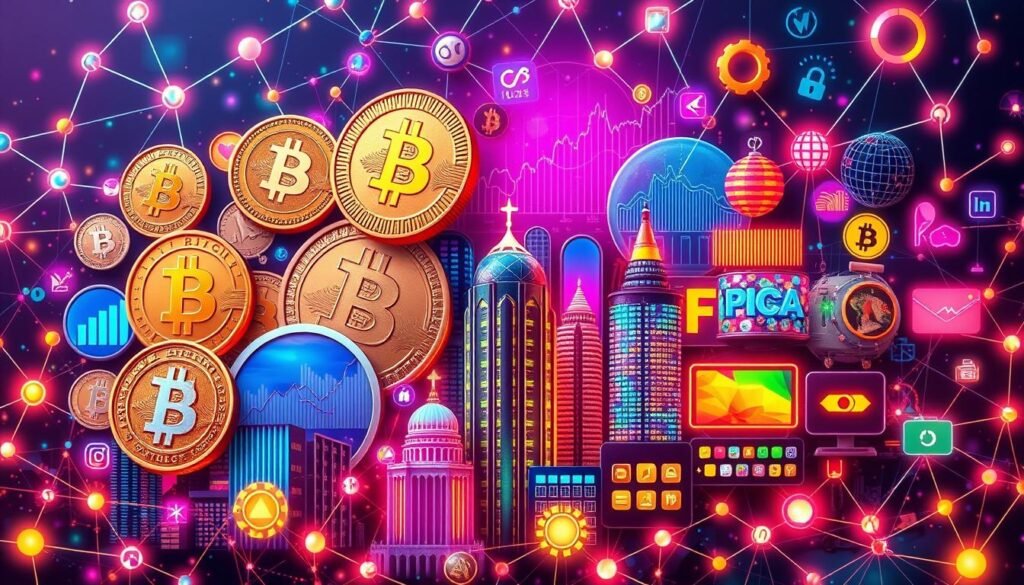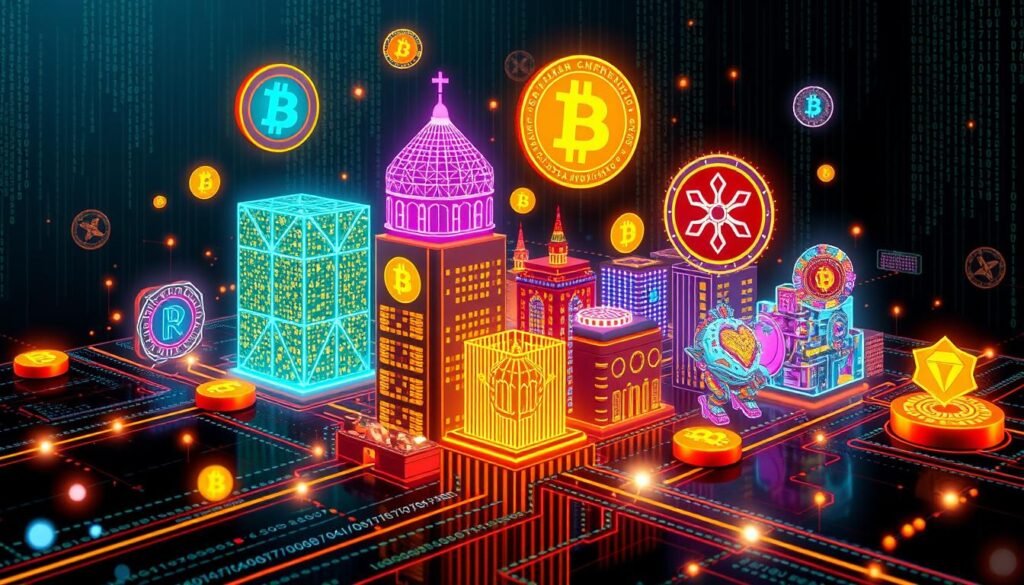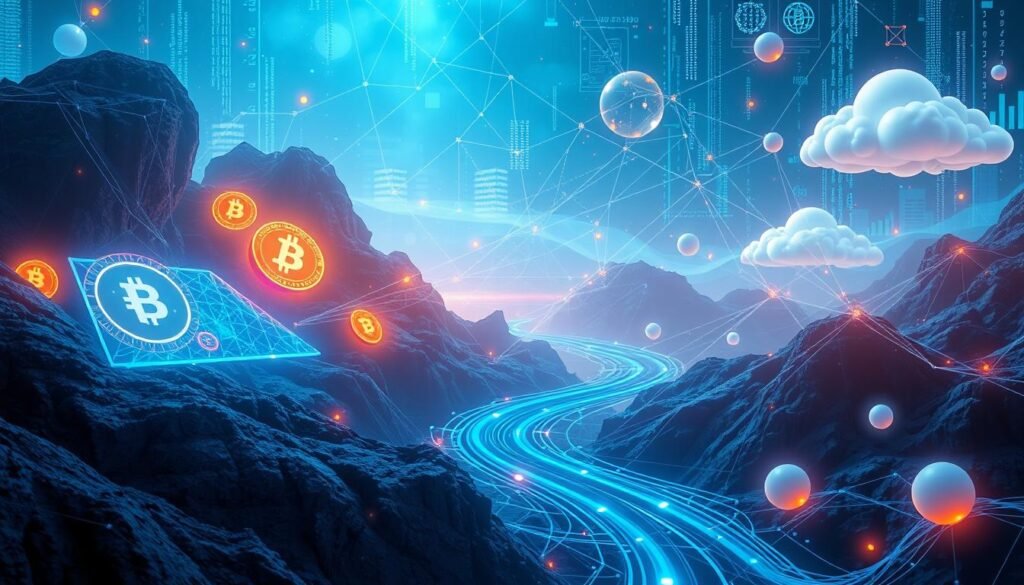Exploring the Journey: Cryptocurrencies to NFTs and Beyond
In today’s digital world, a new kind of asset has appeared digital. These are digital assets, which are intangible and electronic. They have changed how we deal with money, art, and virtual spaces. This article will look into what digital assets are and the many types that have changed our views on ownership, investment, and creativity.
Digital assets include things like cryptocurrencies, non-fungible tokens (NFTs), and virtual real estate. They also include assets from play-to-earn games. These digital values are becoming more common. They offer new chances for investment, ownership, and creativity. As the digital economy grows, it’s important to know about the different digital assets and what makes them special.

Key Takeaways
- Digital assets are a new class of intangible, electronic representations of value that have transformed the digital landscape.
- The diverse types of digital assets include cryptocurrencies, non-fungible tokens (NFTs), digital art, virtual real estate, blockchain-based assets, and decentralized finance (DeFi) tokens.
- Cryptocurrencies, such as Bitcoin and altcoins, are digital currencies that utilize blockchain technology to facilitate secure, decentralized transactions.
- NFTs are unique digital collectibles that use blockchain technology to represent ownership and authenticity of digital items, including art, music, and virtual real estate.
- The digital art and virtual real estate sectors have seen significant growth, with artists and investors capitalizing on the unique properties of these blockchain-based assets.
Understanding Digital Assets
In today’s digital world, assets have changed. They now exist as digital forms. This includes things like cryptocurrencies, non-fungible tokens (NFTs), digital art, and virtual real estate. These digital assets are creating new ways for us to invest, own, and trade.
What Are Digital Assets?
Digital assets are electronic files or data with value. They can be traded, sold, or used in digital transactions. Examples include:
- Cryptocurrencies like Bitcoin and Ethereum
- Non-fungible tokens (NFTs) representing unique digital items
- Digital art, such as paintings, photographs, and animations
- Virtual real estate in online worlds or metaverses
- Digital collectibles and in-game assets
The Importance of Digital Assets
The importance of digital assets is huge. They change how we see ownership, value, and the digital economy. They bring many benefits, like:
- Increased accessibility and global reach for individuals and businesses
- Decentralized ownership and control, reducing the need for intermediaries
- Potential for investment and value appreciation
- Enhanced security and transparency through blockchain technology
- New opportunities for digital creativity and monetization
As the definition of digital assets grows, so will their impact on our digital lives and the economy.

Types of Digital Assets
The world of digital assets is vast and always changing. It includes everything from cryptocurrencies to non-fungible tokens (NFTs). This offers many chances for investors, collectors, and fans.
Cryptocurrencies like Bitcoin and Ethereum are well-known. They’ve changed how we see money and how we do transactions. They offer a safe, decentralized way to handle money.
Non-fungible tokens (NFTs) have also made a big splash. They’re unique digital items that show you own something special. This could be digital art or even virtual land in a metaverse.
The world of digital art and virtual real estate is growing fast. These digital assets let creators and investors show off their work in virtual worlds.
There are many other blockchain-based assets too. This includes digital collectibles, play-to-earn game assets, and decentralized finance (DeFi) tokens. These use blockchain to offer unique ownership and value in different digital spaces.
| Type of Digital Asset | Description | Examples |
|---|---|---|
| Cryptocurrencies | Digital currencies based on blockchain technology | Bitcoin, Ethereum |
| Non-Fungible Tokens (NFTs) | Unique digital assets representing ownership of virtual items | Digital art, virtual real estate, in-game assets |
| Digital Art and Virtual Real Estate | Blockchain-based digital creations and virtual properties | Cryptopunks, Decentraland, Sandbox |
| Blockchain-Based Assets | Digital assets leveraging blockchain technology | Digital collectibles, play-to-earn game assets, DeFi tokens |
The digital asset world is always changing. It offers lots of chances to invest, own, and join in. From cryptocurrencies to NFTs and more, there’s something for everyone.

“The digital asset revolution is transforming the way we think about ownership, value, and the future of the digital world.”
Cryptocurrencies: The Pioneering Digital Assets
Cryptocurrencies have changed the digital asset world, starting a new era in finance. Bitcoin, launched in 2009, led this change. It used blockchain technology, inspiring many other cryptocurrencies, or altcoins, each with its own features.
Bitcoin and Altcoins
Bitcoin is the first and most famous cryptocurrency. It’s known for being decentralized, secure, and limited in supply. This makes it appealing as an investment and alternative to traditional money. Many altcoins have followed, each with new tech and uses.
- Altcoins like Ethereum, Litecoin, and Ripple have brought new features like smart contracts and faster payments.
- They’re used in many fields, from finance to gaming and e-commerce.
- Their growth shows they could change traditional finance, making it more open, secure, and accessible.
As cryptocurrencies grow, more people see their power to change finance.
“Cryptocurrencies represent the future of money and finance, empowering individuals and businesses with new financial possibilities.”
Non-Fungible Tokens (NFTs): Unique Digital Collectibles
In the digital world, non-fungible tokens (NFTs) stand out as unique digital collectibles. They are different from regular cryptocurrencies because each NFT is unique. They can be digital art, a game item, or even virtual real estate.
NFTs use blockchain technology for secure and transparent ownership records. This makes each NFT verifiably unique and valuable. They are great for both collecting and investing.
The growth of NFTs has given digital artists and creators new ways to make money. They can sell NFTs directly to fans, tapping into the demand for unique digital items.
| Characteristics of NFTs | Benefits of NFTs |
|---|---|
| Unique and non-interchangeable Stored on a blockchain Represent ownership of digital assets Cannot be replicated or duplicated | Provide a new way for artists and creators to monetize their work Allow for the creation of scarce and valuable digital assets Enable the trading and investment of digital collectibles Offer a secure and transparent record of ownership and transactions |
The digital world is growing, and so is the market for non-fungible tokens (NFTs) and digital collectibles. This opens up new chances for digital art and other virtual assets.
“The rise of NFTs has ushered in a new era of digital ownership, where unique digital assets can be bought, sold, and traded like physical collectibles.”
Digital Art and Virtual Real Estate
The world of digital assets has grown a lot. It now includes digital art and virtual real estate. These areas offer new chances for creativity, investment, and exploring the metaverse.
Digital Art: Artists are making and selling unique digital artworks. These can be digital paintings, sculptures, or interactive pieces. People buy these digital art pieces to show in their virtual homes or galleries.
Virtual Real Estate: The metaverse has brought us virtual real estate. Here, people can buy and own digital properties. These can be developed, rented, or sold, opening up new investment chances.
As the metaverse grows, so will the value of digital art and virtual real estate. This will give artists, investors, and dreamers new ways to succeed in the digital world.
“The metaverse is the next evolution of social connection. Our goal is to help bring the metaverse to life, so we are focused on building the fundamental technologies to make that possible.” – Mark Zuckerberg, CEO of Meta (formerly Facebook)
Blockchain-Based Assets and Decentralized Finance (DeFi)
Blockchain technology has created a new world of digital assets. These blockchain-based assets can show who owns something online, like in play-to-earn gaming. Also, decentralized finance (DeFi) has brought a new financial system to life, built on blockchain.
DeFi tokens help with lending, borrowing, and trading online. This new way of financing is changing how we think about money. It gives people more control and access to financial services.
- Blockchain-based assets: Digital entities that leverage blockchain technology to represent ownership or rights, such as in-game assets in play-to-earn games.
- Decentralized finance (DeFi): A financial system built on blockchain networks, enabling peer-to-peer lending, borrowing, and trading without the involvement of traditional financial institutions.
These blockchain-based assets and decentralized finance are changing the future of finance and digital ownership. They bring new chances and challenges for everyone.
“The rise of blockchain-based assets and decentralized finance is a testament to the transformative power of technology in the digital age.”
Conclusion
The world of digital assets has grown fast, offering many new ways to invest and own things online. From the first cryptocurrencies like Bitcoin to the latest NFTs and blockchain assets, there’s always something new. This shows how tech keeps improving and how people want new ways to own things digitally.
Digital assets are changing many industries, making new ways to create, invest, and own things. As the digital world gets bigger, it’s key to know what digital assets are and what they can do. This helps both people and businesses to make the most of this changing world.
If you’re into investing in cryptocurrencies, collecting digital art, or exploring virtual real estate, there’s a lot to discover. By keeping up with the digital world, you can find new ways to make money, express yourself, and own valuable digital items.
What are digital assets?
Digital assets are electronic items that hold value or rights. They exist online and can be many things. Examples include cryptocurrencies, NFTs, digital art, and virtual real estate.
Why are digital assets important?
Digital assets are key as our online world grows. They offer new chances for investment and trading. They let people and businesses join the digital world and create value online.
What are the main types of digital assets?
Main types include cryptocurrencies like Bitcoin and Ethereum. Also, NFTs, digital art, virtual real estate, blockchain assets, and DeFi tokens.
What is the difference between cryptocurrencies and other digital assets?
Cryptocurrencies are digital money that use blockchain for secure transactions. They’re fungible, meaning each unit is the same. NFTs and virtual real estate are non-fungible, making each unique.
What are the use cases for non-fungible tokens (NFTs)?
NFTs show ownership of unique digital items. This includes art, collectibles, and virtual items in games or metaverses. They help creators earn money and collectors own unique digital assets.
What is the role of blockchain technology in digital assets?
Blockchain is key for many digital assets. It makes creating, owning, and transferring assets secure and decentralized. It supports new financial and ownership models, like DeFi tokens and in-game assets.
How can individuals and businesses participate in the digital asset ecosystem?
People can invest in cryptocurrencies, buy NFTs, or get virtual real estate. Businesses can use digital assets in their work. This includes accepting cryptocurrencies, selling NFTs, or making dApps on blockchain.